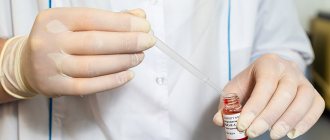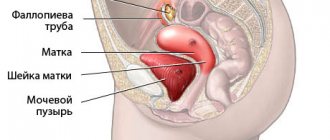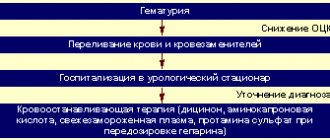When is ultrasound screening done in the 1st trimester?
This event is very important; it is carried out with the aim of identifying various pathologies at an early stage of pregnancy. Screening can be carried out at the request of the expectant mother, but sometimes the doctor strongly recommends undergoing a full examination in order to gain knowledge about possible dangers, as well as for the correct management of pregnancy.
There are the following risk groups for which it is important to undergo an ultrasound in the 1st trimester:
- woman's age over 35 years;
- there was a frozen pregnancy or stillbirth;
- premature births or miscarriages were observed;
- a viral or bacterial disease was detected during pregnancy;
- presence of relatives with genetic diseases;
- a woman during pregnancy was treated with drugs that are contraindicated for pregnant women;
- the father of the child is a blood relative of the pregnant woman.
REFERENCE! Finding any pathologies in the early stages may not be a reason to panic and terminate the pregnancy. This fact should be taken as a signal for more careful monitoring of the course of pregnancy. The earlier a negative factor is identified, the greater the opportunities for its treatment and prevention.
Indications and contraindications for screening
First trimester ultrasound is performed on a voluntary basis. However, obstetricians-gynecologists and the Ministry of Health recommend it to all pregnant women, without exception. Taking care of the health of the unborn child and her own is the patient’s primary task. Ultrasound screenings are among the most common examinations around the world. There are no contraindications to ultrasound, since the study is non-invasive and does not pose a danger to the mother and fetus.
There are several categories of pregnant women whose risks of chromosomal abnormalities are high:
- expectant mothers aged 35 years and older;
- patients who suffered from infectious diseases in the early stages;
- patients taking antibiotics and other drugs incompatible with the situation in the early stages;
- patients with a history of miscarriage;
- women who already have a child with a developmental disability in the family;
- pregnant women with a diagnosed risk of spontaneous abortion;
- patients who are closely related to the child's father.
Why is an ultrasound done in the 1st trimester?
The first screening allows:
- establish the gestational age, which allows you to indicate the expected date of birth;
- diagnose singleton or multiple pregnancy;
- enable the timely appointment of necessary additional studies;
- pay attention to the formation of the placenta and umbilical cord, study of the amniotic membrane;
- in the 1st trimester from 11 to 14 weeks it makes it possible to identify malformations of the child and gain time to conduct genetic research;
- identify a risk group for having children with chromosomal abnormalities (Down syndrome, etc.).
What does biochemical screening examine?
- Free subunit of human chorionic hormone (hCG)
- PAPP-A is pregnancy-associated plasma protein A.
The hCG hormone is produced by the cells of the embryonic membrane (chorion). It is thanks to the hCG analysis that pregnancy can be determined already on the 6-10th day after fertilization. The level of this hormone increases in the first trimester and reaches its maximum by the 10-12th week. Then it gradually decreases and remains constant during the second half of pregnancy.
The hCG hormone is made up of two units (alpha and beta). Of these, beta is a unique one, which is used in diagnostics.
If beta-hCG levels are elevated, this may indicate:
- multiple births (the hCG rate increases in proportion to the number of fetuses);
- Down syndrome and some other pathologies;
- toxicosis;
- diabetes mellitus in the expectant mother;
- incorrectly determined gestational age.
If the beta-hCG level is low, this may indicate:
- presence of ectopic pregnancy;
- non-developing pregnancy or threat of spontaneous abortion;
- delayed development of the unborn baby;
- placental insufficiency;
- fetal death (in the second and third trimester of pregnancy).
How to prepare for an ultrasound in the 1st trimester
In order to prevent the formation of gases in the intestines, which can interfere with making an accurate diagnosis, three days before the ultrasound it is important to exclude from the diet:
- carbonated drinks;
- cabbage in any form;
- legumes;
- dairy products;
- raw vegetables and fruits;
- yeast bread;
- nuts and seeds;
- plenty of sweets.
Excessive eating should also be avoided.
Optimal dishes for ultrasound in the 1st trimester may consist of the following products:
- chicken;
- turkey;
- veal;
- lean fish;
- stewed and steamed vegetables:
- millet or buckwheat;
- yeast-free bread.
IMPORTANT! On the day of the procedure, you should never go hungry; it is better to eat light foods that day.
When performing screening through the abdominal wall, you must drink at least 1.5 liters of water. If the sensor is inserted through the genitals, it is not recommended to drink water several hours before the procedure so that the intestines are free, and the absence of flatulence is also necessary. Before the study begins, there must be a bowel movement. It can be either independent or with the help of espumisan, or with the use of an enema.
NORMAL HCG IN BLOOD SERUM
| HCG levels during pregnancy | HCG norm, honey/ml |
| 1-2 week | 25- 300 |
| 2-3 week | 1500- 5000 |
| 3-4 week | 10000- 30000 |
| 4-5 week | 20000- 100000 |
| 5-6 week | 50000- 200000 |
| 6-7 week | 50000- 200000 |
| 7-8 week | 20000- 200000 |
| 8-9 week | 20000- 100000 |
| 9-10 week | 20000- 95000 |
| 11-12 week | 20000- 90000 |
| 13-14 week | 15000- 60000 |
| 15-25 week | 10000- 35000 |
| 26-37 weeks | 10000-60000 |
PAPP-A (PAPP-A) is a protein that modulates the immune response of the maternal body and is one of the factors ensuring the functioning of the placenta.
The analysis is carried out in the first trimester of pregnancy.
A decrease in PAPP-A levels indicates the likelihood of:
- fetal chromosomal abnormalities;
- Down syndrome, Edwards syndrome, Corneille de Lange syndrome;
- Threats of miscarriage or termination of pregnancy.
Ultrasound standards in the 1st trimester
Of primary importance is the assessment of nuchal translucency thickness (NTT), which makes it possible to identify fetal diseases at the genetic level. In case of anomalies, the TVP is expanded. Limits:
- 10th week: 1.5-2.2 mm;
- 11th week: 1.6-2.4 mm;
- 12th week: 1.6-2.5 mm;
- 13th week: 1.7-2.7 mm.
At 10 weeks, attention is paid to the presence and parameters of the fetal nasal bone. Pathology of the nasal bone is considered:
- aplasia - absence of the nasal bone;
- hypoplasia - change in bone length;
- echogenicity - the degree of tissue density.
It is important to record the baby's heart rate. Limit standards in the 1st trimester include:
- 10th week: 161-179 beats/min;
- 11th week: 153-177 beats/min;
- 12th week: 150-174 beats/min;
- 13th week: 147-171 beats/min.
Coccygeal-parietal size (CTD) is the length of the embryo in the first trimester of pregnancy from the crown to the coccyx. At this time, 45-80 mm is considered the norm.
Biparental head size (BRS) is actually the size of the head from one temple to another. The approximate norm at 12 weeks is 21 mm.
Along with the BOD, it is important to take into account the fronto-occipital dimension (FOR) - the distance from the frontal to the occipital bone. At the first screening, it is usually no more than 31 mm and gradually increases in parallel with the BPD.
The height and weight of the fetus are also taken into account. This indicator is very conditional, but it does exist. At week 11, weight is 11-16 g and height is 6-9 cm
IMPORTANT! All the above digital values are not an unambiguous norm and they are always compared with other parameters, including blood tests.
A non-invasive test that, based on certain laboratory markers and clinical data, allows a computer program to calculate the likely risk of developing chromosomal diseases or other congenital abnormalities of the fetus.
Due to limitations in the use of calculation methods for determining the risk of congenital fetal anomalies, it is impossible to calculate such risks in multiple pregnancies with 3 or more fetuses.
Synonyms Russian
Biochemical screening of the 1st trimester of pregnancy, “double test” of the 1st trimester.
English synonyms
Maternal Screen, First Trimester; Prenatal Screening I; PRISCA I (Prenatal Risk Calculation).
Research method
Solid-phase chemiluminescent enzyme-linked immunosorbent assay ("sandwich" method), chemiluminescent immunoassay.
Units
MME/ml (milli- international unit per milliliter), IU/L (international unit per liter).
What biomaterial can be used for research?
Venous blood.
How to properly prepare for research?
- Eliminate fatty foods from your diet 24 hours before the test.
- Avoid physical and emotional stress for 30 minutes before the test.
- Do not smoke for 30 minutes before the test.
General information about the study
Down's disease is a chromosomal disease associated with a disorder of cell division (meiosis) during the maturation of sperm and eggs, which leads to the formation of an additional 21st chromosome. The frequency in the population is 1 case in 600-800 births. The risk of chromosomal abnormality increases with the age of the mother and does not depend on the health status of the child’s mother or environmental factors. Edwards syndrome (trisomy 18) and Patau syndrome (trisomy 13) are less associated with maternal age, with a population incidence of 1 in 7000 births. Accurate prenatal diagnosis of genetic diseases requires invasive procedures that are associated with a high likelihood of complications, so mass screening uses safe research methods to identify low or high risk of chromosomal abnormalities and assess the feasibility of further examination.
Prenatal screening for trisomy in the first trimester of pregnancy is performed to determine the likely risk of chromosomal pathology of the fetus - trisomy 21 (Down syndrome), as well as trisomy 18 (Edwards syndrome) and trisomy 13 (Patau syndrome) between the 10th week and 13th week and 6 days of pregnancy. It is calculated using the PRISCA (Prenatal Risk Calculation) computer program developed by Typolog Software (Germany) and having an international certificate of conformity. For the study, the content of the free beta subunit of human chorionic gonadotropin (hCG) and pregnancy-associated plasma protein A (PAPP-A) in the blood of a pregnant woman is determined.
The PAPP-A enzyme ensures the full growth and development of the placenta. Its content in the blood increases as pregnancy progresses. The level of PAPP-A does not significantly depend on parameters such as the sex and weight of the child. In the presence of a chromosomal abnormality with fetal malformations, its concentration in the blood decreases significantly from the 8th to the 14th week of pregnancy. It decreases most sharply with trisomies on the 21st, 18th and 13th chromosomes. In Down syndrome, the PAPP-A level is an order of magnitude lower than in normal pregnancy. An even more dramatic decrease in the concentration of PAPP-A in the mother’s blood serum is observed when the fetus has a genetic pathology with multiple malformations – Cornelia de Lange syndrome. However, after 14 weeks of pregnancy, the value of determining PAPP-A as a risk marker for chromosomal abnormalities is lost, since its level is then normal even in the presence of pathology.
For screening, clinical data (pregnant woman’s age, body weight, number of fetuses, presence and characteristics of IVF, mother’s race, bad habits, presence of diabetes mellitus, medications taken), ultrasound data (coccygeal-parietal size (CPR) and nuchal translucency thickness) must be taken into account (TVP), nasal bone length). If ultrasound data is available, the gestational age is calculated based on the CTE value, and not on the date of the last menstruation.
After the study and risk calculation, a scheduled consultation with an obstetrician-gynecologist is carried out.
The results of a screening study cannot serve as criteria for making a diagnosis or as a reason for artificial termination of pregnancy. Based on them, a decision is made on the advisability of prescribing invasive methods of examining the fetus. If the risk is high, additional examinations are necessary, including chorionic villus puncture, amniocentesis with genetic testing of the material obtained.
What is the research used for?
- For screening examination of pregnant women to assess the risk of chromosomal pathology of the fetus - trisomy 21 (Down syndrome), Edwards syndrome.
When is the study scheduled?
- When examining pregnant women in the first trimester (analysis is recommended for pregnancy 10 weeks - 13 weeks 6 days), especially in the presence of risk factors for the development of pathology: age over 35 years;
- history of miscarriage and severe pregnancy complications;
- chromosomal pathologies, Down's disease or congenital malformations in previous pregnancies;
- hereditary diseases in the family;
- past infections, radiation exposure, taking medications that have a teratogenic effect in the early stages of pregnancy or shortly before it.
What do the results mean?
Reference values
- Pregnancy-associated plasma protein A (PAPP-A)
| Week of pregnancy | Reference values |
| 8-9th | 0.17 - 1.54 MME/ml |
| 9-10th | 0.32 - 2.42 MME/ml |
| 10-11th | 0.46 - 3.73 MME/ml |
| 11-12th | 0.79 - 4.76 MME/ml |
| 12-13th | 1.03 - 6.01 MME/ml |
| 13-14th | 1.47 - 8.54 MME/ml |
- Free beta subunit of human chorionic gonadotropin (beta-hCG free)
| Week of pregnancy | Reference values |
| 8-9th | 23.65 - 162.5 ng/ml |
| 9-10th | 23.58 - 193.13 ng/ml |
| 11-12th | 17.4 - 130.38 ng/ml |
| 12-13th | 13.43 - 128.5 ng/ml |
| 13-14th | 14.21 - 114.7 ng/ml |
| 14-15th | 8.91 - 79.44 ng/ml |
| 15-16th | 5.78 - 62.07 ng/ml |
| 16-17th | 4.67 - 50.05 ng/ml |
| 17-18th | 3.33 - 42.81 ng/ml |
| 18-19th | 3.84 - 33.3 ng/ml |
Based on the examination of the pregnant woman, the PRISCA program calculates the likelihood of developmental defects. For example, a ratio of 1:400 shows that, according to statistics, one out of 400 pregnant women with similar indicator values gives birth to a child with a corresponding malformation.
What can influence the result?
- The result is influenced by the accuracy of the information provided and the ultrasound diagnostic findings.
- A false positive result (high risk) in some cases may be associated with an increase in the beta subunit of human chorionic gonadotropin due to placental dysfunction and the threat of miscarriage.
Why is it recommended to choose a paid clinic?
Paid clinics are equipped with modern equipment for conducting research. In government institutions you need to take a number of things with you (diaper, shoe covers, towel, etc.), but in paid clinics all this is usually provided.
It is worth considering that this procedure is performed not only for pregnant women. When performing a free ultrasound, there are queues; as a rule, the procedure is carried out by appointment, and people sign up for the queue a month or two in advance, but in a paid clinic there are rarely queues. When selecting a clinic, you should pay attention to the availability of a license, work experience and qualifications of specialists. When you contact the Diamed clinic, you will be provided with all the necessary documents. Come to us!
References
- Tsibizova, V.I., Govorov, I.E., Pervunina, T.M. and others. Prenatal screening of the first trimester in multiple pregnancies. Part I: comparative analysis of serum proteins PPAP-A and β-hCG during pregnancy occurring spontaneously or as a result of in vitro fertilization. Obstetrics, gynecology and reproduction, 2021. - No. 1. - P. 25-33.
- Normal pregnancy. Clinical recommendations. Society of Obstetricians and Gynecologists of Russia, 2021. - 80 p.
- Makarov, I.O., Yudina, E.V., Borovkova, E.I. etc. Prediction of adverse pregnancy outcomes based on biochemical screening in the first trimester. Obstetrics, gynecology and reproduction, 2011. - No. 1. - P. 18-21.
- Poon, L., McIntyre, H., Hyett, J. et al. The First trimester of pregnancy — A window of opportunity for prediction and prevention of pregnancy complications and future life. Diabetes research and clinical practice, 2021. - Vol. 145. - P. 20-30.
Second trimester screening
The pregnant woman is sent for a second planned ultrasound at 18–22 weeks. This study will definitively confirm or refute the presence of congenital malformations, even those that may not be detected during the first screening. Prenatal determination of their presence becomes the reason for prescribing additional diagnostic procedures that will finally determine whether such a pregnancy needs to be prolonged. Otherwise, at up to 22 weeks, it is still possible to terminate the pregnancy for medical reasons without causing artificial labor.
It is important to do a maternal assessment at this stage of pregnancy and determine whether the woman needs corrective therapy, which is usually aimed at maintaining the pregnancy. Screening during pregnancy allows you to assess the condition of the internal os of the cervix. The cervix must remain closed until the last weeks of pregnancy, otherwise the patient is given special sutures or pessaries to prevent spontaneous miscarriage.
A diagnostician examines the condition of the placenta. The most important characteristics are:
- location of the placenta;
- its thickness;
- its degree of maturity.
The data obtained is used for preliminary planning of the method of delivery, identifying the likelihood of fetoplacental insufficiency, assessing the development of maternal organs and the ability to fully carry a pregnancy to term.
In the second trimester, the amount of amniotic fluid is of great importance. By calculating the amniotic fluid index using ultrasound, it is possible to determine polyhydramnios or oligohydramnios, which can negatively affect the development of the fetus.
Additional ultrasounds
Sometimes a doctor can refer a pregnant woman for ultrasound diagnostics not three, but more times during the entire period of bearing a child. This need arises in cases where, based on the results of tests or other methods for monitoring the condition of a pregnant woman, abnormalities have been identified or the woman has had disturbing symptoms.
Additional ultrasound - unscheduled screening - is prescribed regardless of the stage of pregnancy in the following cases:
- if a pregnant woman has pain in the lower abdomen, heavy vaginal discharge of unknown origin, especially with an unpleasant odor, weakness or dizziness;
- when a woman does not notice fetal movements even after 20 weeks;
- if a pregnant woman has suffered bacterial or viral infections at any stage of pregnancy;
- in the case when labor activity began before 36 weeks; the study can be carried out even during contractions;
- on the eve of the expected date of birth, if the third ultrasound determined a dangerous presentation of the fetus;
- before birth to determine the final location of the fetus and choose delivery tactics.
Screenings at a later date
The third screening is aimed primarily at fetometry and monitoring the condition of the placenta. The doctor determines the size and weight of the fetus, whether it is ready for birth, and what position it occupies in the uterus. In the later stages, it is important to monitor the amount of amniotic fluid, blood circulation and monitor pregnancy emergencies. Carrying out the procedure also helps to choose a birth scenario.
All ultrasound screenings are carried out using expert-class devices that accurately determine the characteristics. The examination is carried out by doctors who specialize in identifying certain abnormalities. Therefore, it is very important to choose the right medical center in which the procedures are performed.
The Zdorovye family clinic is equipped with the most modern ultrasound diagnostic equipment and conducts research at all stages of pregnancy. We will perform a complete screening and help you obtain complete information about the condition and development of your unborn child.
Ultrasound with Doppler in the third trimester
According to indications, an additional Doppler ultrasound may be prescribed - a study that allows you to assess the blood supply to the fetus. During Doppler, the speed of blood flow in the umbilical cord, vessels of the uterus, middle cerebral artery, and fetal aorta is studied. The study allows you to determine whether the fetus has enough oxygen and nutrients for full development.
Indications for prescribing Doppler ultrasound:
- umbilical cord entanglement;
- Rhesus conflict pregnancy;
- fetoplacental insufficiency;
- history of pregnancy pathologies;
- diabetes;
- gestosis;
- multiple pregnancy;
- unsatisfactory cardiogram result;
- small increase in the height of the uterine fundus;
- if the size of the fetus determined on a previous ultrasound does not correspond to the actual gestational age.
Doppler ultrasound may also be prescribed in the second trimester if there is a suspicion of fetal hypoxia.
Fetometry in the second trimester
The second ultrasound screening of pregnant women also involves conducting detailed fetometry of the fetus and assessing the dynamics of fetal development. To do this, a competent diagnostician first studies the results of the first screening carried out at 10–13 weeks of pregnancy, after which he conducts an ultrasound examination of the fetus to determine the most important parameters of the fetus:
- Head circumference;
- abdominal circumference;
- size and location of internal organs;
- thigh length;
- biparietal size, etc.
Based on the ultrasound results obtained, the doctor makes a conclusion about the exact duration of pregnancy and determines whether the fetus has intrauterine growth retardation (IUGR). If there is a suspicion of IUGR, ultrasound diagnostics are performed on the patient every 2 weeks.
The second ultrasound screening is the most anticipated for most parents, as it allows one to determine the gender of the unborn child with great certainty. This fact comes under the control of a doctor only in the case when the future parents have a serious hereditary disease in their family that is transmitted only to a certain gender, for example, hemophilia in boys.









